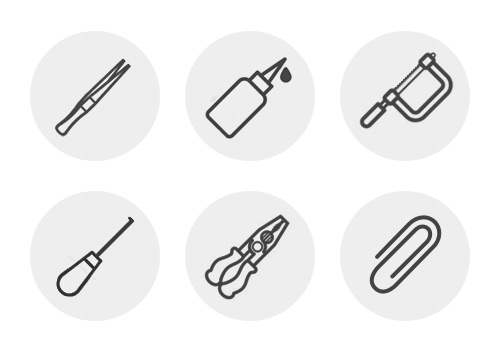
Did you know that over time your keys can weaken? Just like with anything it can suffer from wear and tear with the metal softening. And, this means, it’s susceptible to breaking. When you put your key in a lock and hear a stomach-turning crack, it’s safe to say your key has snapped off inside. You can pretty much guarantee that this highly annoying event will happen at the most inconvenient time too.
But, the first thing to remember is don’t panic! While your immediate reaction may be to call a locksmith, in most cases you can save yourself time and money by using a few simple tools to get the key out yourself.
Lucky for you, we’ve listed 6 effective ways to extract a broken key from a lock. Although, it’s important to note that each situation will be different, so, make sure you choose wisely and if you’re not confident in removing it yourself, then a locksmith probably will be the best option.

What You’ll Need:
- Tweezers
- Superglue
- Hacksaw blade
- Broken key extractor
- Pliers
- Paper clips
Before choosing your method, first, ask yourself some questions to really gauge the situation. How much time do you have on your hands? What tools are readily available? How deeply is the broken key inserted in the lock?
The last thing you want to do is try to reinsert the other half of the key to try and turn the broken half. This can very easily push the broken key into the lock further and ultimately damage the lock itself – making things much more difficult.
It’s also a good idea, before starting the extraction process, to apply some kind of lubricant to the keyhole such as WD-4O to help get the broken key out faster.
1. Tweezers
Tweezes are often the first port of call when it comes to broken keys in a lock. This method can be a bit of a hit or miss but it may be worth a go in desperate times. The main thing to watch out for is the thickness of the tweezers. If they’re the wrong thickness they could end up pushing the broken key in the lock further. Ideally, your tweezers should be open wide enough to fit around the key but not so thick that they can’t fit along the sides.
If you can see part of the key protruding from the lock, then you’ll have the best success retrieving it with tweezers. They can provide just the right amount of precision to quickly remove it. We’d advise not squeezing too hard on the tweezers as when the tweezers shut it will very slightly push the key back. This means each failed attempt to grip the key will make it more difficult to remove.
2. Super Glue
If you consider yourself a pro at the game Operation, then the super glue method could work for you. Really though, this method should be a last attempt as the glue makes it extremely risky and could potentially damage your lock. It also only works if the broken key is somewhat accessible. The idea is to find a small piece of wire or a matchstick or something small and thin that can fit in the keyhole. Then, apply a single drop of superglue on the end of the object and carefully insert it into the lock, making sure not to touch the sides at all.
Hold the wire/matchstick against the key, being careful not to push it and wait a few minutes for the glue to dry and bind to the key. You should then be able to remove the object and pull out the key with it.
3. Hacksaw Blade
Small jigsaw or hacksaw blades can work fantastically as a key extractor. If the serrations on the blade are angled, you can often push them into the top part of the keyhole, making sure the serrations are pointing back toward you. Push the blade far back enough into the lock and in a position where the serrations can be used to hook onto the broken part of the key. When you feel the blades latch onto the key, give it a slight twist and a pull and the broken key should slide smoothly out.
One thing to keep in mind with this method is to not force the blade into the keyhole, it should be able to fit smoothly. If you find the need to force it, make adjustments to the blade to make it thin enough to fit.

4. Broken Key Extractor
It may surprise you to learn that there is such a thing as a broken key extractor tool. This tool is what professional locksmiths use in these types of situations. While it may not be something you’ll have to use often, it can certainly come in handy at the most unexpected times. If you live close by to a hardware store and you have time, we’d recommend running out to get one as it’s the easiest and safest way to remove a key.
This tool works in a similar way as the hacksaw blade method. Simply place it inside the keyhole, along the biting of the key. You’ll then be able to try and hook the teeth on the key with the hooks of the extractor. When you feel it catch, turn and pull the key out in a smooth motion. It might take several attempts but it is by far the best method.
5. Tap the Cylinder
If your key has snapped in a padlock or a bike lock then this method should work well for you as you’ll need to be able to point the keyway down toward the ground. While the lock is positioned downward, strike the lock on a solid surface or with a hammer and let gravity do the rest. The broken part of the key should slide out with the lock remaining intact.
It may take several strikes with a hammer or other hard object before the key comes out. But, if you find you’re excessively hitting the lock with no or little results then you may need to consider taking it to a professional to help.
6. Paper Clips
Paper clips can be used in the same way as a hacksaw blade or an extractor tool, or they can be used to probe and pull the key out. If you’re particularly skilled in lock picking (we won’t ask how) then this could be the method for you. Unfurl two paper clips until they are just two thin lines of metal and line a piece up on both sides of the broken key. They don’t have to go too far into the lock, just enough so you are able to apply pressure. Then, slowly pull the broken key towards you. It may only move a bit at a time so patience will be required.
Keep repeating the process until the key is fully out. If you’re not having much luck, you can try turning your wrists inward while the paper clips are still in the keyway to twist and jiggle the broken key slightly which should make it easier to retrieve.
If after all your efforts, you discover that your lock is busted and you require a new one, take a look at our wide range of door locks and latches, from modern to traditional styles each with varying levels of security.
